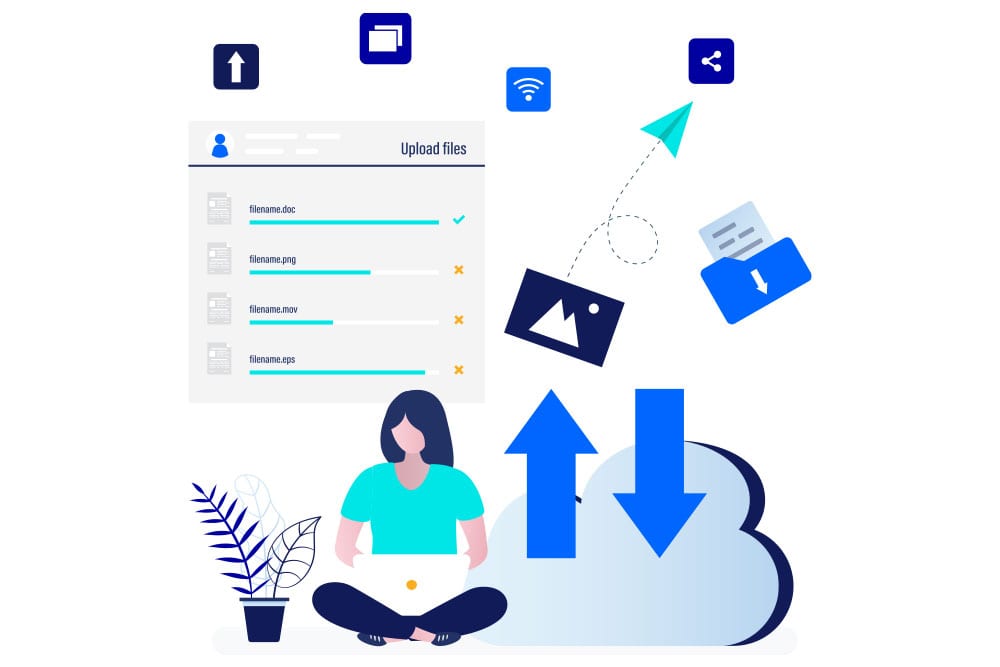In the first of this blog series, What is cloud content management?, we looked at the ongoing evolution from Enterprise Content Management (ECM) to cloud-based content services and the benefits that this new approach can bring to your organization. In this blog, we’re going to examine the business drivers behind the adoption of cloud content services and ask why you need a cloud-based content management solution.
It all starts with information. Content and data. Unstructured and structured. Every business creates a mountain of both. In the past, however, we’ve not been very good at fully extracting the value they contain. Early ECM solutions concentrated on the storage and governance of content rather than how people use the information. Organizations are now realizing they need to extract as much value as possible from their content and data—while also improving the governance capabilities of their infrastructure.
This has resulted in the market for content management and content services solutions to grow rapidly. Research from estimates that the cloud enterprise content management market will be over $32 billion by 2022. Other research firms are even more bullish. HBV Research puts the global market for cloud content management platforms at over $63 billion by 2024.
This growth is being significantly driven by the evolution from content management to cloud content services. In this new world, traditional content management functionality is a foundation that allows cloud content management to make information available in the most natural way possible to the people and processes that need it. It allows them to concentrate on their tasks and goals rather than searching, retrieving and managing the content themselves.
Let’s just quickly recap a definition of cloud-based content management software.
What is cloud content management?
Rather than acting as a simple repository for all enterprise content, cloud content management builds on the core tenets of content services technology to improve the value and minimize the risk of a wide variety of information. With that in mind, a better name would be cloud content services. Content services are a set of services and micro services that are delivered as an integrated product suite or as separate applications sharing common APIs and repositories.
These services can manage any type of content and integrate with any process or application. More importantly, cloud content services can be tailored to specific use cases and business requirements; they can be easily customized to meet integration protocols as well as how specific pools of information are managed, distributed and used.
Today, most organizations look to deliver content services through a cloud content management platform—such as OpenText Extended ECM or OpenText Documentum—that provides a wide range of capabilities to address the value and risk of content across its entire lifecycle.
Cloud content management platforms should:
- Manage any volume or type of content and the related metadata
- Provide foundational library services such as template documents, version management, search, viewing and markup as well as reporting and mobility
- Control security and privacy of all information regardless of the repository
- Provide robust integration across enterprise and specialized applications
- Align content to related processes in both the front and back office, often spanning multiple enterprise systems and functional areas
- Automate content-centric activities and provide intelligent insights based on business context
- Enable seamless and secure internal and external collaboration with business partners and customers
- Deliver comprehensive information governance and content integrity throughout its lifecycle, ensuring compliance for every industry and geography
- Focus on empowering knowledge workers and improving their productivity to facilitate digital business transformation
7 reasons you need cloud content management solutions
When it comes to content, cloud services have a number of advantages that are either absent or more difficult to attain with traditional on-premise content management solutions. Chief among these is the ability to simplify, accelerate and greatly expand the management of a wide range of content types and information flows—both on-premise and in the cloud. This opens up many new use cases within an organization and allows enterprises to focus on opportunities, not challenges.
We’ve highlighted seven business drivers for cloud-based content management systems.
1: Accelerating digital transformation
According to Forrester, cloud content services are foundational to upgrading customer and employee experiences, both of which are consistently shown as a major driver behind digital transformation initiatives. Through digital transformation, enterprises are looking to create an organization-wide advantage of automated processes, customer-centric services and seamless information flows. As 2021 dawns, the only plausible way to achieve this is through a cloud-based content management platform that’s architected to:
- Meet the information needs of an organization
- Produce an integrated ecosystem of different information sources and formats
- Manage and apply security and access controls
- Measure the quality of information
- Classify and tag information so it can be found and retrieved by services and apps
- Provide insight to drive process automation and improve decision-making
Deploying the right cloud content management platform dramatically increases your chances of digital transformation success. McKinsey found that companies that used digital tools to make information more accessible across the organization were twice as likely to succeed.
2: Increasing the value of content
According to IDC estimates, the world will generate about 175 zettabytes of content by 2025, more than four times the amount today. The Economist suggests that digital information is increasing 36% worldwide each year. This is a massive deluge—and 80% of it is unstructured content.
The Economist describes data as “the world’s most valuable resource”. But, information is only truly valuable when it’s used to its potential. From the standpoint of cloud content management, that means being able to draw insight from that information and making it available to the people who need it.
The vast majority of content in today’s digital business is created and consumed at the edge. This requires a new computing paradigm where lightweight content services quickly and accurately deliver information where it’s needed, both through integrating with other business applications and presenting it in a way that’s easy to use. A key element of this for cloud-based content management platforms is the automated creation of metadata that allows all content to be effectively tagged for quick retrieval.
Information has to be able to be extracted from its original content format and structured in a way that will allow AI-assisted analytics to be applied. The best cloud content platforms have AI-driven analytics embedded within the solution.
3: Business agility
Cloud-based content management solutions allow information to be more accessible than ever to both your workforce and the partners they collaborate with. Content is stored locally, while being managed centrally and seamlessly shared across offices, regions and time zones. The entire organization is able to work better, faster and smarter.
Content cloud offers other advantages when it comes to agility. A cloud content management system integrates with front and back office applications to become a system of record for enterprise content, but it delivers integrated content management in a way that monolithic ECM systems never could. Cloud-based content services applications use containerized architecture to maximize customization and built-for-purpose implementations. By breaking down ECM features and functions into easily modifiable elements, you can quickly create cloud content services that meet specific business use cases.
Finally, cloud services allow organizations to stay current with the latest version of their cloud content management software. Updates and upgrades are often automatically applied, freeing internal resources and minimizing disruption to the overall platform.
4: Informed collaboration
Unstructured collaboration is all the documents, chat messages, video calls and email chains that drive everything from product advances to customer experience. It’s the day-to-day interaction between employees, partners, vendors and even customers. It’s primarily the realm of the Microsoft Office suite.
However, all that innovation and judgement is dependent on information. Ideas and decisions are only as good as the information they’re based on. And, the information generated by that collaboration has value beyond its immediate use. The best cloud content management platforms integrate with the benchmark collaboration tools in Office to underpin and support their strengths.
They connect the activities in Outlook, Teams and Word with relevant content and data drawn from across the enterprise. For example, SAP data can be automatically surfaced in Outlook to support related emails.
Integrating cloud-based content services solutions to collaborative tools introduces enterprise-level governance and control to information generated through collaboration. Content developed in Teams is automatically identified, classified and incorporated into the central content management program. Legally defensible governance is applied and the content is available through search and information feeds to others across the enterprise.
Cloud content services applications such as OpenText Core Share extends that control beyond the organizational “moat”. Collaboration from any location has centrally defined permission, versioning, auditing and retention rules applied.
5: Cost reduction and administration simplicity
Installing and maintaining a cloud content management system is cheaper and simpler than on-premises content management. As with other types of cloud services, you can remove most of your capital expenditure in IT infrastructure. The cloud service provider takes responsibility for upgrades and patches as well as handling technical issues and data security. Cloud-based content management also delivers scalability; it is easy and quick to add or delete functionality and individual users as business needs change.
6: Process automation
Digitizing business processes has become a key driver for ECM investment. An integral component of that is automating as many tasks and workflows as possible across low-value, repetitive functions such as capture, case management and accounts payable. Letting technology do the work vastly expands through-put capabilities and removes user error from the equation. The new generation of cloud-based content services platforms offer AI-driven automation capabilities that feed directly into workflows and value chains.
To meet the growing demand for process automation, the best cloud-based content management platforms have been architected to extend into key business processes and systems to provide consistent access to information as well as instill governance. For example, inventory reports, service contracts, customer correspondence and other content can be automatically connected and compiled from multiple sources. They can all be made available directly to customer service teams with centrally managed permission and editing rules in place.
7: Employee productivity and engagement
Information silos make content difficult to access, often causing a great deal of extra work and frustration for employees. According to IDC, an average worker can spend a third of their working life searching for information—flipping screens, changing applications, even reaching out to others for needed content and data. This, of course, takes away from the valuable tasks a worker could be doing.
Traditional ECM was created to provide a baseline solution to this issue but it still required the relevant information to be stored together in a central repository and the user had to go looking for that information—often having to undertake at least some of the tagging and information management work themselves. Cloud-based content management systems change the paradigm by managing information in its originating system and pushing that information to other systems or processes rather than waiting for the user or system to pull the information from a central storehouse.
Workers no longer have to spend hours looking for documents and content. In addition, cloud content services mean that many people can work on the same content simultaneously while maintaining information integrity and version control.
By improving their access to information, cloud-based content management increases both employee productivity and engagement. This offers direct bottom-line benefits to your organization. Research has shown that companies with engaged employees are likely to be 21% more profitable.
Growth of the hybrid deployment model
Cloud content service technology dramatically advances the ability of content management platforms to connect and integrate with an ever-increasing number of specialized applications driving processes across the enterprise. As organizations reach new levels of information sprawl with more systems and applications than ever before, a cloud native content management solution facilitates the interoperability process and breaks down the barriers between information silos in a seamless, low-touch way that is virtually impossible for on-premise ECM systems.
However, no one should ever assume that these critical and peripheral systems—and the information they generate—will be cloud based in the near future. A number of factors, from budgeting cycles to information security requirements, mean organizations will be operating in a hybrid environment for years to come. The leading content management platforms may be cloud based but are easily adaptable to this reality. They offer the best of both worlds: the information security and compliance strengths of on-premise with the accessibility, interoperability and collaboration benefits of cloud content services.
Until enterprises move all their content into the cloud, a content management solution that adapts to the needs of a hybrid approach is the only way to meet both the information sharing and collaborative needs of your workers as well as the governance and compliance requirements of the business.
Find out more about cloud content management solutions from OpenText.




